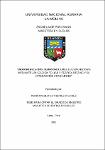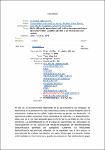Mostrar el registro sencillo del ítem
Biofortificación agronómica del cultivo de papa mediante aplicación foliar y edáfica de Zinc y su interacción cn Cadmio
| dc.contributor.advisor | Vega Ravello, Ruby Antonieta | |
| dc.contributor.advisor | Egúsquiza Bayona, Rolando Percy | |
| dc.contributor.author | Gutierrez Vilchez, Pedro Pablo | |
| dc.date.accessioned | 2019-01-02T16:54:48Z | |
| dc.date.available | 2019-01-02T16:54:48Z | |
| dc.date.issued | 2018 | |
| dc.identifier.other | F04.G888-T BAN UNALM | |
| dc.identifier.uri | https://hdl.handle.net/20.500.12996/3769 | |
| dc.description | Universidad Nacional Agraria La Molina. Escuela de Posgrado. Maestría en Suelos | es_PE |
| dc.description.abstract | El zinc es un micronutriente importante en la salud humana; sin embargo, su deficiencia en la población ha sido considerada como un factor limitante para el crecimiento normal de los niños, especialmente en países en desarrollo. La agricultura podría considerar como alternativa de solución a la biofortificación, dado que es la vía más accesible para incrementar la cantidad de zinc en los alimentos. La biofortificación es el proceso de incrementar los contenidos de micronutrientes en los cultivos sea mediante programas de fitomejoramiento (biofortificación genética) y/o agregando nutrientes vía fertilizantes (biofortificación agronómica). Además, se ha reportado que el zinc reduce la acumulación de cadmio en plantas, un metal tóxico que incrementa ciertas enfermedades en los humanos y puede acumularse en los tubérculos de papa que es el alimento más consumido en muchos lugares del mundo por ser parte de la dieta diaria como en el Perú. Durante la campaña 2017, se instaló el experimento para conocer la respuesta del cultivo de papa (Solanum tuberosum L.) a la fertilización con zinc en suelos moderadamente alcalinos (pH 1:1 = 7.82) de la costa peruana, con un nivel de CaCO3 de 3 %, P extractable de 16.2 mg kg-1 y Zn extractable de 14.55 mg kg-1. Las parcelas fueron distribuidas en un diseño de bloques completamente al azar con cuatro repeticiones. Los tratamientos consideraron aplicaciones de zinc al follaje (5 kg Zn ha-1) e incorporaciones de zinc al suelo (0, 20 y 40 kg Zn ha-1). La fertilización edáfica fue realizada a la siembra y las aplicaciones foliares se realizaron a los 40, 47, 54 y 61 DDS. Las variables en estudio fueron rendimiento y concentración de Zn en la hoja y en el tubérculo (cáscara y pulpa). Los resultados indican que el aporte creciente de Zn edáfico con y sin aplicación foliar no muestran diferencias significativas en la producción de papa. Por otro lado, la concentración de Zn en las hojas y en el tubérculo fueron mayores cuando el Zn se aplicó foliarmente. En los tratamientos con aplicación foliar, las concentraciones de Zn en la hoja, cáscara y pulpa fueron de 166.0, 49.3 y 24.6 mg kg-1, respectivamente; mientras que en los tratamientos sin aplicación foliar se obtuvo 69.7, 41.4 y 18.5 mg kg-1. Estadísticamente, no se apreció reducción en la concentración de Cd por la fertilización de Zn. | es_PE |
| dc.description.abstract | Zinc is an important micronutrient in human health; however, its deficiency in the population has been considered as a limiting factor for the normal growth of children, especially in developing countries. Agriculture could be considered as an alternative solution to biofortification, because it is the most accessible way to increase the amount of zinc in food. Biofortification is the process of increasing micronutrient contents in crops either through breeding programs (genetic biofortification) and / or by adding nutrients using fertilizers (agronomic biofortification). In addition, zinc has been reported to reduce cadmium accumulation in plants, a toxic metal that increases certain diseases in humans and can accumulate in potato tubers which is the most consumed food in many places in the world for being part of the daily diet as in Peru. During the 2017, the experiment was installed to know the response of the potato crop (Solanum tuberosum L.) to the fertilization with zinc in moderately alkaline soils (pH 1: 1 = 7.82) of the Peruvian coast, with a level of CaCO3 of 3%, extractable P of 16.2 mg kg-1 and extractable Zn of 14.55 mg kg-1. The plots were distributed in a randomized complete block design (RCBD) with four repetitions. Research consider to study two factors: a) levels of soil fertilization and b) with and without foliar application, in total six treatments. Soil fertilization levels were 0, 20 and 40 kg Zn ha-1 and the foliar dose was 5 kg Zn ha-1 Soil Zn fertilization was applicate at planting and foliar fertilizations were applicated at 40, 47, 54 and 61 days after planting. The yield and other biometric parameters, zinc and cadmium analysis in the leaf and tuber (flesh and skin), were evaluated. Soil Zn fertilization with and without foliar application does not show significant differences in potato production. However, Zn concentration in leaves and tuber were higher with foliar Zn fertilization. In the treatments with foliar application, the Zn concentrations in the leaf, skin and flesh were 166.0, 49.3 and 24.6 mg kg-1, respectively; while in the treatments without foliar application, 69.7, 41.4 and 18.5 mg kg-1 were obtained. There were no significant differences in the reduction in the Cd concentration for Zn fertilization. | en_US |
| dc.description.uri | Tesis | es_PE |
| dc.format | application/pdf | en_US |
| dc.language.iso | spa | es_PE |
| dc.publisher | Universidad Nacional Agraria La Molina | es_PE |
| dc.rights | info:eu-repo/semantics/openAccess | en_US |
| dc.rights.uri | https://creativecommons.org/licenses/by-nc-nd/4.0/ | * |
| dc.source | Universidad Nacional Agraria La Molina | es_PE |
| dc.source | Repositorio institucional - UNALM | es_PE |
| dc.subject | Solanum tuberosum | es_PE |
| dc.subject | Oligoelementos | es_PE |
| dc.subject | Cinc | es_PE |
| dc.subject | Cadmio | es_PE |
| dc.subject | Aplicación foliar | es_PE |
| dc.subject | Evaluación | es_PE |
| dc.subject | Concentración | es_PE |
| dc.subject | Tuberculo | es_PE |
| dc.subject | Perú | es_PE |
| dc.subject | Aplicación edafica | es_PE |
| dc.subject | Biofortifiación agronómica | es_PE |
| dc.subject | Fertilización foliar | es_PE |
| dc.title | Biofortificación agronómica del cultivo de papa mediante aplicación foliar y edáfica de Zinc y su interacción cn Cadmio | es_PE |
| dc.title.alternative | Agronomic biofortification of potato through foliar and soil fertilization with zinc and its interaction with cadmium | en_US |
| dc.type | info:eu-repo/semantics/masterThesis | en_US |
| thesis.degree.discipline | Suelos | es_PE |
| thesis.degree.grantor | Universidad Nacional Agraria La Molina. Escuela de Posgrado | es_PE |
| thesis.degree.name | Magister Scientiae - Suelos | es_PE |
| thesis.degree.level | Maestría | es_PE |
| dc.subject.ocde | https://purl.org/pe-repo/ocde/ford#4.01.06 | es_PE |
Ficheros en el ítem
Este ítem aparece en la(s) siguiente(s) colección(ones)
-
M-SUE Tesis [32]




